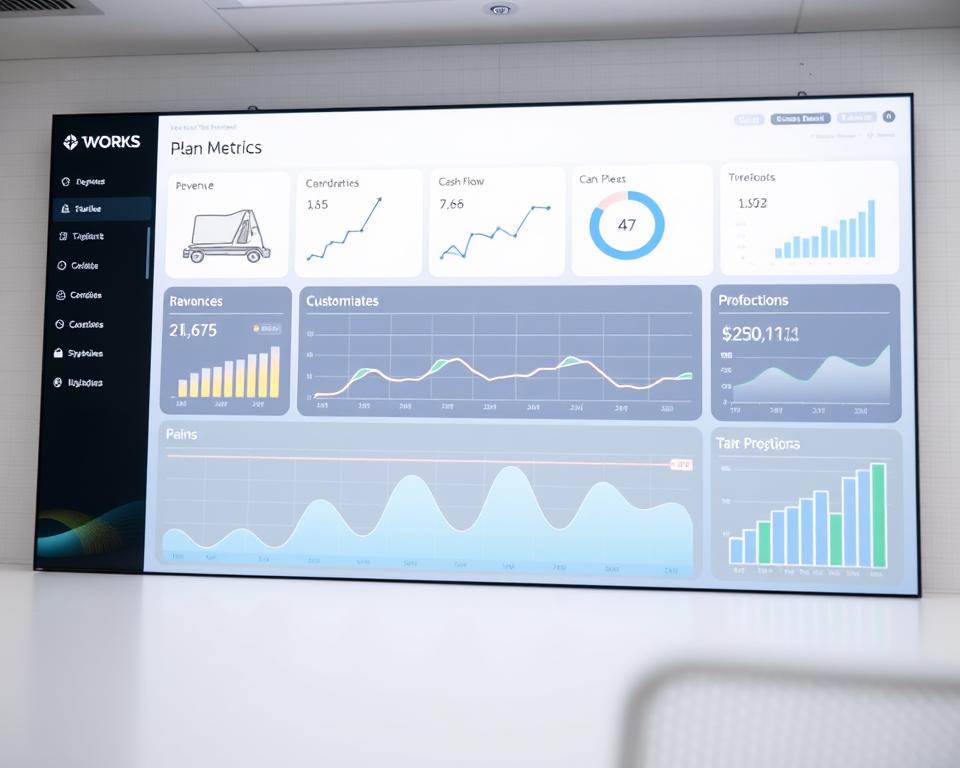Anuncios
What if a short plan could save months of guesswork and cash?
This guide frames a living plan as your central tool for clear goals and better daily work. A plan links marketing, sales, operations, and financial metrics like net profit margin and current ratio. Use simple tests, weekly reviews, and a small monthly dashboard to measure progress without grand promises.
Data matters: the U.S. Bureau of Labor Statistics notes about 20% of new firms fail in year one and roughly 50% by year five. Free resources such as SCORE and SBA Small Business Development Centers offer practical planning help business owners use.
You will find clear examples, checks for loans and cash control, and steps for separating personal and business money. Try ideas on a small scale. Measure outcomes. Iterate. This section sets the stage for a concise plan you can apply right now.
Introduction: why “how to Business” matters in 2025
A small, testable plan saves months of guesswork and preserves capital. Many founders skip customer checks and fail: CB Insights finds 35% of startups collapse from no market need. The U.S. Chamber’s 2025 guidance stresses pre-launch research, MVP tests, and soft launches as low-cost ways to learn.
Anuncios
This guide gives a practical map for small business founders. You get clear example checklists, simple dashboards, and a timeline that keeps weekly and quarterly reviews manageable. We tie each step to current U.S. rules, like sales tax nexus for multistate online sales and required registrations.
Use evidence-based iteration: run quick MVPs, gather customer feedback, measure results, and adjust offers before scaling. Free resources such as the SBA and SCORE provide mentoring and planning resources nationwide.
- Practical steps most owners face in 2025
- Customer discovery paired with market signals
- Actionable templates: MVP tests, soft launches, dashboards
Define your model: customers, market, and value proposition
Begin with a clear sentence that states who you serve and the pain you remove. Say that sentence aloud and refine it until it’s sharp. That line will guide product choices, pricing, and outreach.
Anuncios
Clarify the problem you solve and for whom
Write one-sentence customer + problem statements. Then list the top three outcomes your product service delivers.
- Core customer and must-solve problem (one sentence)
- Top three outcomes your product or product service provides
- Quick validation: 5 interviews or a 3-question survey
Positioning against competitors and substitutes
Size your market practically: count reachable customers in your region or channel and test willingness to pay with short interviews and MVP tests.
Map substitutes and competitors by shopping, reading reviews, and tracking pricing pages. Note where your offering wins: value, speed, convenience, or lower total cost of ownership.
Draft a one-line positioning statement naming the audience, problem, category, and primary benefit. Test it in outbound messages and on a simple landing page, then capture every customer learning in a shared doc for weekly updates.
Build a living business plan that you actually use
Create a living roadmap that links goals, metrics, and the work you do every day. A practical plan stays small, focused, and updated on a fixed cadence so it guides choices rather than gathering dust.
Executive summary, mission, and goals
Write the executive summary last. Distill mission, target market, offer, and top goals into one page you review each week. Keep top goals measurable and tied to KPIs like net profit margin and AR turnover.
Products and services: pricing, fulfillment, and IP
List each product or service with clear pricing logic and fulfillment steps. Note any trademarks or patents you will pursue and keep simple process checks for quality and delivery.
Marketing, operations, and finances
Align marketing and sales with market insights: pick a primary channel and one secondary channel. Document suppliers, an org chart, and cost drivers in plain language.
Statements, projections, and cadence
Include profit and loss, balance sheet, and cash flow. Update monthly and build conservative year-by-year projections tied to capacity and marketing inputs. Use basic software and an appendix for licenses, contracts, and resumes.
- Consejo: Avoid optimism; base forecasts on data.
- Consejo: Set a monthly review so the plan stays a living resource.
Market research that reduces risk and waste
Good market work turns opinions into clear, testable choices. Start with public data and competitor counts to build simple assumptions. This gives quick context before you ask customers for information.
Demand, size, saturation, pricing, and engagement signals
Estimate demand using census data, industry reports, and competitor listings. Then sanity-check those numbers in short conversations.
Capture engagement with a lean landing page and a waitlist. Measure click-through rate and sign-ups as early signals of interest.
Customer discovery: interviews, surveys, MVP tests
Run 10–20 interviews that probe jobs-to-be-done and price sensitivity. Use neutral example questions that reveal behavior, not wishful answers.
- Draft assumptions from secondary information, then validate with primary interviews.
- Build a basic MVP and run paid or organic tests; compare conversion and retention to expectations.
- Log every interview and test result, then turn insights into decisions on product scope, pricing, and messaging.
Repeat small tests when conditions change. Treat research as a recurring habit that helps you prioritize limited resources and avoid big, costly mistakes common with many startups.
Choose your legal structure and register the right way
Your legal structure sets rules for ownership, credit building, and risk. Pick an entity that matches your plans for taxes, liability, governance, and fundraising.
Quick view: common forms include sole proprietorship, partnership, LLC, S corporation (requires IRS Form 2553), and C corporation. Each has trade-offs for owner protection and tax reporting.
Entity trade-offs
Compare liability, taxation, governance, and future funding needs. Talk with an accountant or attorney before you file.
Name, trademark, and filings
Run a state registry search and a USPTO TESS check to reduce rebranding risk. File formation documents with your Secretary of State and register any DBA per local rules.
EIN, hiring, records
- Get an EIN from the IRS (free) to open accounts and run payroll the right way.
- Know when hiring employees triggers new registrations and compliance steps.
- Keep a checklist of required information, fees, renewal dates, licenses and permits that apply to your industry.
Consejo: your choices affect owner liability and how your company builds business credit over time. Keep organized records and consult a professional for tailored guidance.
Licenses, permits, and sales tax compliance
Licensing rules and sales obligations shape what you can sell and where you must collect taxes. Start early: missing a required license or sales registration can trigger fines and slow growth.
Federal and state permits by industry
Some products and services need federal licenses. Examples include alcohol, wildlife, and broadcasting.
States and localities often require permits for construction, food service, and specialty trades. Use your state business portal for current information and renewal dates.
Consejo: identify federal requirements first, then compile state and local items before you begin sales or hire staff.
Post-Wayfair sales tax nexus for e-commerce
After South Dakota v. Wayfair (2018), many states set economic nexus rules. Your remote sales may create tax obligations even without a storefront.
- Track each state’s revenue or transaction thresholds and register where you exceed them.
- Set processes to calculate, collect, and remit sales tax accurately and on time.
- Keep proof of registrations and filings updated every year and store them with your records.
- Consider how compliance affects pricing, cash timing, and customer experience.
Verify requirements with official agencies or a qualified professional before launch. This brief overview is not exhaustive but helps you prioritize the checks that protect revenue and customer trust.
Banking, accounting software, and cash flow discipline
Treat your accounts as guardrails: clear separation and simple automation keep money available when you need it.
Open a dedicated business bank account first. Bring your EIN, formation documents, and any required licenses. A separate account makes taxes, audits, and reporting far easier and protects personal credit.
Pick the right software and automate statements
Choose accounting software that fits your stage and skillset. Good tools generate a P&L, balance sheet, and a monthly cash flow statement automatically.
Automate monthly statement generation and bank feeds so reconciliation is a short, regular task.
Cash controls: terms, invoicing, and reserves
Set clear payment terms, standardize invoices, and follow a strict collections cadence. Prompt invoicing and one or two polite follow-ups cut AR days.
- Keep a basic reserve and a small revolving line for bumps; define rules for when you draw credit.
- Reconcile accounts monthly and track a short metric list: net profit margin, current ratio, and AR turnover.
- Integrate payroll if you have employees so tax deposits never miss deadlines.
Standardize approvals for spending, store vendor and company records in one place, and review your cash position each week. These small habits protect money and make financing decisions clearer when you need credit or growth capital.
Funding and financing options without overextending
Pick money sources that match the life of your expense, not the loudest pitch. Match short-term needs like payroll or seasonal inventory with a line for operating cash. Use term loans for long-lived assets such as equipment or real estate.
Debt options include term loans, revolving lines of credit, equipment loans, and invoice financing. Compare the true cost: interest, origination fees, and prepayment penalties before you sign.
Non-debt alternatives include angels, venture capital, and crowdfunding (rewards or equity). These suit startups and growth plays when you can show rapid traction or product-market fit.
- Match funding to purpose and time: use a line for working capital and a term loan for durable assets.
- Plan repayment: tie schedules to realistic sales and cash flow projections using simple pro formas.
- Personal credit: treat it as a last resort and document a clear repayment plan.
Avoid stacking advances that compound costs. Reassess funding quarterly and raise only what advances your next learning milestones. Conservative assumptions protect runway and keep growth choices flexible.
Operations, team, and leadership habits for small business
A steady rhythm beats frantic work: set short cycles that move projects forward.
Organize work: priorities, cadences, and vendor management
Set weekly priorities so the team knows what “done” looks like. Run a short planning meeting and a weekly review. Track three metrics that matter for your company.
Use vendor scorecards and simple SLAs to keep partners aligned. Add a light operating manual that captures handoffs and quality checks. Small, clear rules cut rework and save time.
Hiring employees vs. contractors and compliance basics
Decide based on control, continuity, and legal risk. Document roles, tests, and expected outcomes so classification is clear. Misclassification can trigger tax and payroll problems, so consult guidance for compliance.
- Build brief onboarding checklists and a single-page manual.
- Practice service habits that protect customer trust and boost sales.
- As the owner, guard focused work blocks and keep a queue of process improvements.
Consejo: track workloads and handoffs weekly. Run small experiments and frequent adjustments to improve throughput and morale.
Marketing and sales engine that compounds over time
Focus on repeatable marketing routines that build trust and measurable leads over time. Start small, measure impact, and invest more in the channels that show clear returns.
Website, SEO, and local presence
Launch a clean website with clear offers and structured SEO basics. Optimize titles, meta descriptions, and fast loading pages so search engines and people find your products and service.
Claim your Google Business Profile and keep hours, contact info, and reviews current. Local visibility drives place-based discovery and higher conversion for nearby customers.
Email list, content, and social proof
Build an email list with simple lead magnets and send helpful content that brings people back. Use testimonials and reviews ethically; display them where they influence buying decisions.
Collect consent, show real results, and include basic license or registration numbers in copy when required for trust and compliance.
Outbound, partnerships, and referrals
Run focused outbound and partner campaigns with clear targets and tracked outcomes. Measure meetings booked, conversion rate, and revenue per campaign.
Pick two channels to master. Set modest weekly tests with defined success thresholds. Use fair billing terms and clear payment expectations so credit and reputation remain strong.
- Consejo: Align spend with measured returns; stop tests that underperform.
- Consejo: Use partnerships and referrals to accelerate sales without heavy ad spend.
- Consejo: Keep claims honest and match your capacity to protect reputation and compliance.
Growth strategies, competition, and risk management
Not every expansion makes sense now; match moves with evidence and guardrails. Pick growth paths that fit your team, cash, and customer signals. Balance speed with service quality so goals stay realistic.
Four clear growth paths
Define choices plainly:
- Organic — more customers, higher conversion, repeat sales.
- Strategic — new channels or offers that scale outreach.
- Partnership/M&A — deals that open markets but add complexity and risk.
- Internal — process, efficiency, and product improvements that lift capacity.
Assess, time, and protect the company
Compare each option against your plan and resources. Model best, base, and worst cases for the next year, including hiring and capacity needs.
Track competitors and market signals—price moves or launches often show timing. Use lightweight pre-mortems and set financing thresholds: only seek a loan or other financing when demand is validated and repayment looks realistic.
Document decisions and revisit them quarterly so you learn, adjust strategy, and keep risk manageable.
how to Business with metrics, examples, and action plans
A compact KPI set makes decisions faster and budgets safer for early teams.

Set targets that map to cash and delivery. Pick five core measures: monthly revenue, gross margin, customer acquisition cost (CAC), lifetime value (LTV), and accounts receivable turnover. Add churn or repeat rate if your services need it.
Set targets and track KPIs: revenue, margin, CAC, LTV, ARTR
Define each KPI in one line so everyone shares the same statement. For example, CAC equals total marketing and sales spend divided by new customers that month.
Link every metric to an owner and an action. If CAC rises above your threshold, pause that channel, run a quick test, or reallocate budget.
Example dashboards for startups and established companies
Use your accounting software or a spreadsheet to build a simple dashboard with three to five panels. Show trend lines for revenue, margin, cash flow, and AR days.
Track product and product service performance separately so you can see contribution margin differences at a glance.
Quarterly action plans: experiments, budgets, and reviews
Run a quarterly cycle: review P&L, balance sheet, and cash flow, then set 3–5 experiments with small budgets and clear success criteria.
- Time-box tests and compare against a control.
- Assign owners, spending limits, and decision gates.
- Document each example and learning so future choices cost less and move faster.
Tips: build dashboards that surface issues early, align sales goals with capacity and cash, and keep budget discipline so credit or cash gaps never surprise you.
Conclusión
, End with a calm plan: choose one or two small tests in the place that teaches fastest. Track simple metrics and protect cash so you spend less time guessing and more time learning.
Use public resources like the SBA and SCORE for practical advice and mentoring. Treat licenses and permits as ongoing obligations: review them as your footprint changes and keep compliance current.
Focus on products and services that show traction, conserve money, and use scarce resources well. Set clear goals, keep a tiny dashboard, and scale what works slowly so growth stays sustainable and steady.



